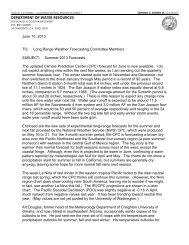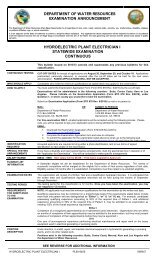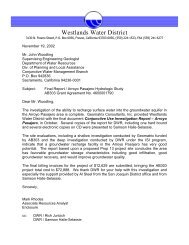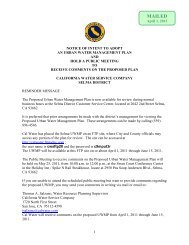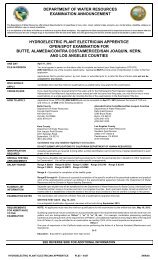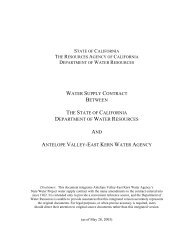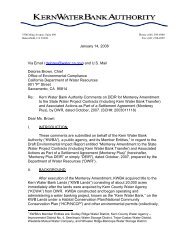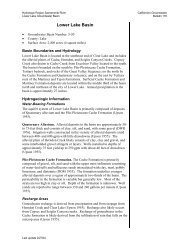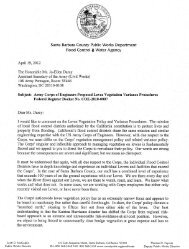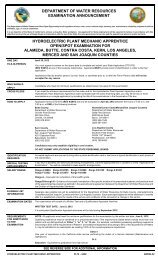Bulletin 1.pdf - California Department of Water Resources - State of ...
Bulletin 1.pdf - California Department of Water Resources - State of ...
Bulletin 1.pdf - California Department of Water Resources - State of ...
Create successful ePaper yourself
Turn your PDF publications into a flip-book with our unique Google optimized e-Paper software.
414 WATER RESOURCES OF CALIFORNIA<br />
flOOD FLOWS<br />
Histories <strong>of</strong> early settlements in Sacramento Valley mention a great<br />
flood in 1805 which is supposed to have covered the entire valley except<br />
the Sutter Buttes. It is related that thousands <strong>of</strong> Indians were drowned.<br />
Stories handed down by Indians and trappers tell <strong>of</strong> another flood <strong>of</strong><br />
large but indeterminate magnitude in 1825. There are reliable accounts <strong>of</strong><br />
devastation that year in the south, but the authenticity <strong>of</strong> Indian legends<br />
regarding devastion in the north is questionable.<br />
The Forty-Niners met their first flood in 1849-50, when the Sacramento<br />
Valley was partially inundated. It is reported that small mountain<br />
streams became raging torrents, and that the larger rivers generally<br />
flooded wide stretches <strong>of</strong> the valley floor. According to one early writer,<br />
"The valley <strong>of</strong> the Sacramento was like an inland sea, and the city <strong>of</strong><br />
Sacramento became a second Venice," and "instead <strong>of</strong> gondolas, the<br />
honest miners navigated the submerged streets in wagon-boxes, bakers'<br />
troughs, crockery crates, and on rafts made <strong>of</strong> whiskey-kegs."<br />
Descriptions <strong>of</strong> the floods <strong>of</strong> 1861-62, by Thomas Rowlandson, are<br />
contained in Bancr<strong>of</strong>t's "Hand-Book Almanac for the Pacific <strong>State</strong>s,<br />
1863. " Following these floods, the author toured the West Coast from<br />
Mexico to the Canadian border. He states that there were three heavy<br />
storms between December 9, 1861, and January 10, 1862, extending the<br />
full length <strong>of</strong> the Pacific Coast. Each was preceded by a heavy snowfall<br />
that reached to the valley floors. According to William H. Brewer'8<br />
description <strong>of</strong> these floods in "Up and Down in <strong>California</strong> in 1860-1864,"<br />
the "great central valley" <strong>of</strong> the <strong>State</strong> was under water-"a region 250<br />
to 300 miles long and an average <strong>of</strong> at least 20 miles wide, a district <strong>of</strong><br />
5,000 or 6,000 square miles, or probably three to three and a half million<br />
acres." Thousands <strong>of</strong> farms, he stated, were entirely under water, with<br />
cattle starving and drowning.<br />
In January, 1862, the American River rose to a height probably not<br />
since equalled. Many bridges were destroyed, isolating whole communities,<br />
and at Folsom a flour mill was washed away taking with it a wire<br />
suspension bridge. The attested high water mark <strong>of</strong> this flood, made on an<br />
old stone stable on the left bank <strong>of</strong> American River 1.5 miles above Folsom,<br />
indicates that the flood crest would have registered 39.3 feet on the<br />
present gage at Folsom, or 7 feet higher than the crest <strong>of</strong> March, 1928.<br />
After the flood <strong>of</strong> 1861-62, it was estimatedthat more than one-fourth<br />
<strong>of</strong> all taxable property in the <strong>State</strong> had been destroyed, and the <strong>State</strong><br />
Treasurer thought the tax list would be cut one-third. This was the greatest<br />
and most disastrous general flood in <strong>California</strong> <strong>of</strong> which there is<br />
authentic record, and there is much interesting and reliable information<br />
available regarding it. Some <strong>of</strong> the local newspapers, notably the" Sacramento<br />
Union" and the "Alta <strong>California</strong>." carried day-by-day accounts<br />
<strong>of</strong> its progress.<br />
There have been many damaging floods in the Central Valley Area<br />
since 1861-62. One <strong>of</strong> the greater <strong>of</strong> these was in 1907 when an estimated<br />
300,000 acres <strong>of</strong> reclaimed land in the Sacramento-San Joaquin Delta<br />
was submerged. owing to the breaking <strong>of</strong> many levees. During four days<br />
from March 18th to 21st the mean flow from the Sacramento and San<br />
Joaquin River watersheds was about 732,000 second-feet. Floods in 1909<br />
were comparable in run<strong>of</strong>f and disaster to any known up to that time, and<br />
conditions were again critical in 1911. Records at gaging stations on many



